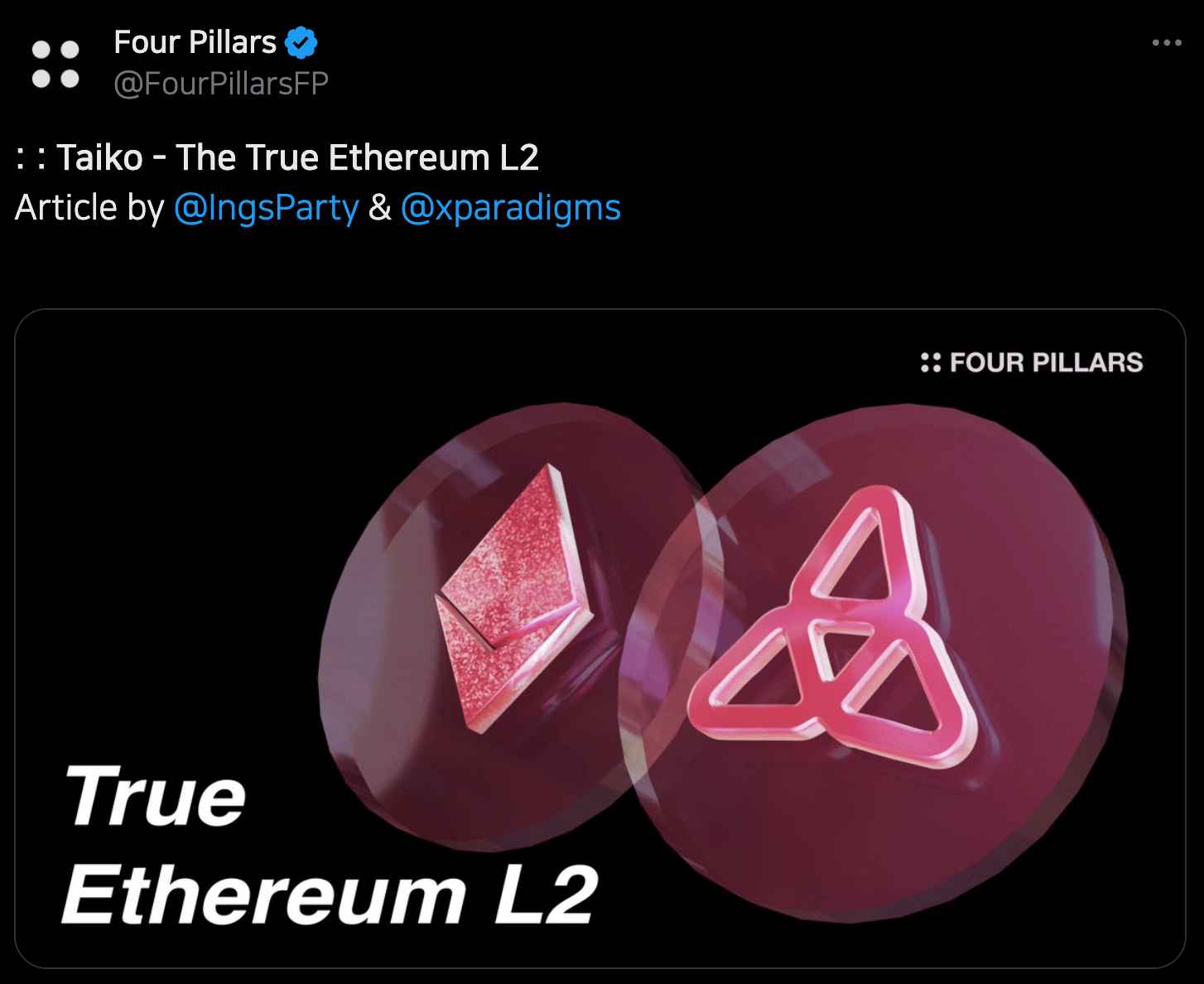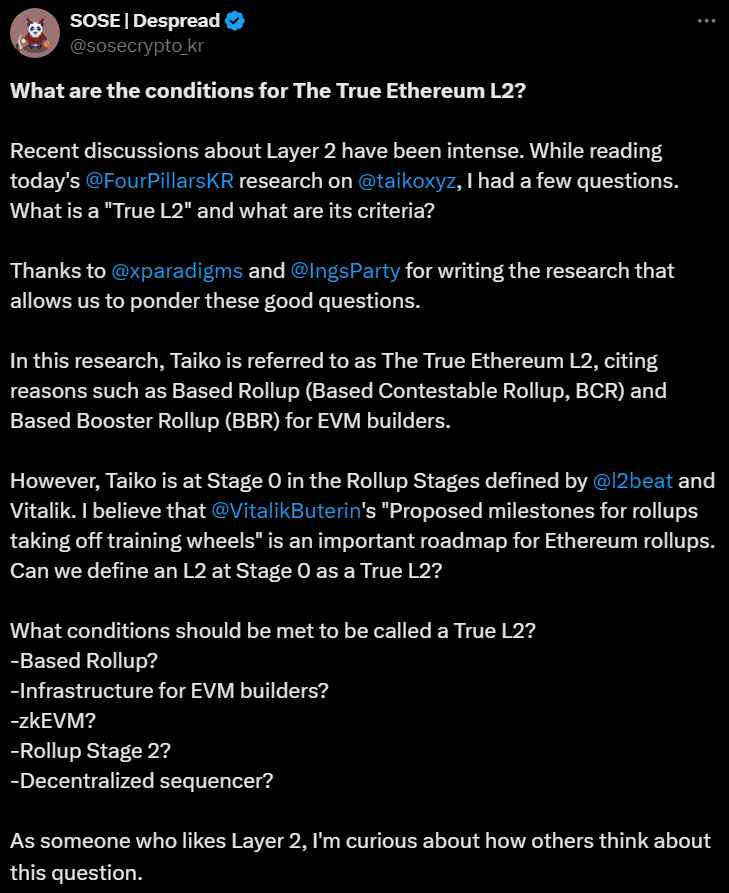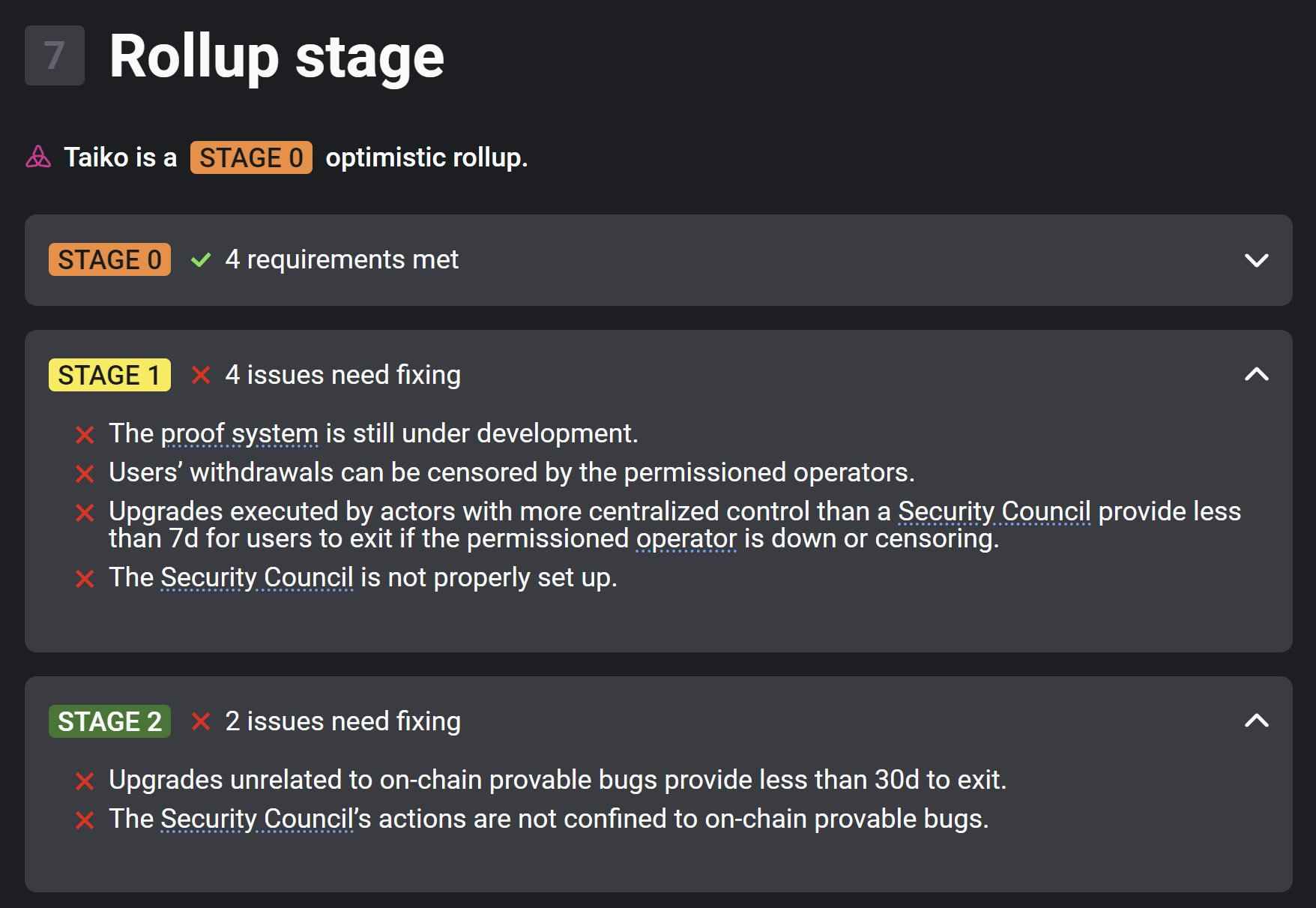*Special Thanks to Sose for bringing up this discussion.

Source: FourPillarsFP X
Recently, an article titled "Taiko - The True Ethereum L2" was published by FourPillars, introducing Taiko and describing it as the “True Ethereum L2.” This phrase sparked a debate on X about what qualifies as a True Ethereum L2 and what conditions must be met to achieve this title. The term "True" in this context implies a measure of correctness, which seems to have fueled the intensity of the discussion.
This article aims to revisit the heated debate, giving readers an opportunity to think about what it means to be a True Ethereum L2. Before diving into the debate, it's essential to understand the Rollup stages, which are frequently referenced in the discussion. Understanding these will help in following the rest of the article more smoothly.
The stages of Rollup (L2) proposed by Vitalik Buterin categorize the development stages of many Rollup (Optimistic and ZK Rollups) projects, focusing on temporary safety mechanisms called "training wheels." Vitalik emphasizes that while Rollup projects should aim to remove these training wheels, they should not be removed until the system is fully prepared to operate without them.
Stage 0: Full Training Wheels
The project should be referred to as a Rollup.
All Rollup transactions must be recorded on-chain.
Users should be able to post Rollup transactions and withdraw assets without operator intervention, except in the case of a fraudulent state root. Operators should not be able to freeze or steal users' assets.
The on-chain mechanism for posting new state roots should use a multisig, with no need for fraud or validity proofs.
Stage 1: Limited Training Wheels
A fraud or validity proof system must be operational.
The security committee should use a strict multisig scheme (e.g., 6/8), with some participants from outside the organization running the Rollup.
An upgrade mechanism may exist, but at least a 7-day delay is required to prevent malicious upgrades.
Stage 2: No Training Wheels
Unless there’s a bug in the code, no group should be able to ignore the code's output and post a state root.
The security committee should intervene only in the case of obvious bugs.
Upgrades should require at least a 30-day delay.
With this basic understanding of the Rollup stages, let’s examine the origins of the debate around the “True Ethereum L2.”

Source: SOSE | Despread X
The debate began with Sose’s question asking what the conditions are for a True Ethereum L2. He pointed out that while Taiko is referred to as a 'True L2' for specific technical reasons, it is still in Stage 0 according to the Rollup stages defined by Vitalik and L2Beat. By inviting others to share their opinions, Sose ignited the debate.
The key participants in the debate were Sose from Despread, Heechang from Four Pillars, Ingeun Kim from Four Pillars, and sm-stack from Kroma. Their discussions focused on what direction and conditions must be met to become a True Ethereum L2. Readers are encouraged to consider these different perspectives and expand their own thinking without seeking a definitive right or wrong.
The initial discussion between Sose and Heechang centered around the conditions for becoming a True Ethereum L2, along with supporting arguments. The key points are summarized as follows:
To qualify as a True Ethereum L2, the project must satisfy the other two aspects of the blockchain trilemma: security and decentralization. To meet these conditions, a trust-minimized environment should be built, based on decentralized sequencing, permissionless proof and output proposals, and the removal of upgrade keys.
To achieve these conditions, Taiko has a concrete roadmap for decentralization. It plans to realize these goals through two key elements: L1-verifier-based sequencing and the Based Contestable Rollup (BCR).
Additionally, projects like Arbitrum, and Optimism are also striving to become true Ethereum L2s.
Arbitrum's decentralization roadmap includes three key developments: BoLD (H2 2024), which enhances security and enables safe decentralized validation, moving Arbitrum closer to Stage 2 rollup status; Censorship Timeout (H2 2024), which builds on BoLD to improve censorship resistance and user fund access; and Decentralized Sequencer (likely 2025), the final step that distributes transaction ordering responsibilities across a broader network, reducing censorship risks and enhancing reliability. These upgrades collectively aim to improve Arbitrum's security, decentralization, and overall performance.
Also, Optimism is putting its focus on its decentralization roadmap. The plan involves creating a trustless fault proof system with multiple functioning proving mechanisms and establishing a security council. Optimism has prioritized the development of a modular, open-source OP Stack that enables rapid multiproof expansion. This strategy has allowed ecosystem developers to work on alternative fault proof implementations in parallel. The Optimism ecosystem has already ratified a 14-member security council and is working towards having this council manage upgrade keys independently from the Optimism Foundation by 2024.
Since each project has its own unique approach, it is worth paying attention to their individual progress rather than rigidly defining the conditions for a True Ethereum L2.

Source: l2beat Taiko Rollup Stage
Next, the discussion between Sose and Ingeun Kim shifted to the relationship between Rollup stages and what constitutes a True Ethereum L2. They debated whether Taiko is in Stage 0 or Stage 1, but the main takeaway is that the proximity to becoming a True Ethereum L2 isn’t determined solely by the Rollup stage. Instead, it depends on how well the project maintains the Ethereum ecosystem and EVM compatibility while achieving scalability.
The main criteria supporting this view are:
How tightly integrated is the L2’s Rollup process with L1?
How quickly and easily can solutions be provided to builders who most need scalability within the L1 ecosystem?
Taiko is steadily preparing to meet these criteria. Through the Based Rollup model, Taiko ensures that its sequencer’s responsibilities are shared with L1’s transaction explorers or block builders, fulfilling the integration criterion. Moreover, its Based Booster Rollup (BBR) allows builders to deploy DApps from Ethereum L1 to L2 without significant changes, offering lower gas fees and faster transaction speeds.
However, without entry into Stage 2, it may be difficult for many builders and users to recognize Taiko as a True Ethereum L2. Although BBR enhances scalability, it should not be seen as the sole criterion for determining whether a project qualifies as a True Ethereum L2.
Finally, the discussion between sm-stack and Ingeun Kim focused on how simply applying the Based Rollup is not enough for becoming a True Ethereum L2—user security is equally critical. The main points are:
Taiko is superior to other Stage 0 Rollups, but it still needs further development in terms of security, just like other Stage 0 L2 projects. Since Rollups inherit Ethereum’s security, they must ensure robust user security, free from trust assumptions, to distinguish themselves from sidechains or Plasma.
While Based Rollup is designed for censorship resistance and modularity, it is not directly related to user security, which prevents centralized actors from stealing user funds. However, if the L2 ecosystem grows and decentralized incentives for sequencers are established, Based Rollup could indirectly improve user security.
The two main questions and answers about Taiko’s technical features are:
Does Taiko’s Rollup process truly integrate with L1, and are L1 explorers and builders actively participating in Taiko’s block sequencing process?
→ Currently, participation is low, but this is due to the low MEV revenue and fees. However, L1 and L2 remain connected because the L1 verifier and L2 sequencer share responsibilities and authority.
Is the claim that BBR allows DApp deployment from L1 to L2 without significant changes applicable to all EVM-compatible Rollups, or does it uniquely benefit certain builders relying on L1 data?
→ Efficient DApp deployment is influenced by factors like consistent smart contract language, compiler support, and Ethereum client consistency. BBR takes it further by offering a multi-Rollup environment where deployment on L1 automatically extends to L2, enhancing scalability.
Nevertheless, further discussion and implementation are needed to improve user security in projects like Taiko. Alongside this, incentivizing the decentralization of sequencers remains a challenge.

Source: Vitalik Buterin X
Recently, L2 projects have been proliferating, and discussions about L2 are becoming more frequent. Reflecting these trends, Vitalik Buterin recently declared that starting next year, he will only discuss L2s that have reached Stage 1 or beyond in his blogs or lectures. He hinted that while he may offer short grace periods for new projects, Stage 1 or higher is essential for projects to be worthy of discussion.
Vitalik's statement may indicate that he sees a need for clearer guidelines on what constitutes a True Ethereum L2. Although such guidelines have not been explicitly established, debates like the one outlined here are necessary. L2 projects must collaborate and contribute to shaping the L2 ecosystem rather than merely following the conditions set by Vitalik.
The definition of a true Ethereum L2 and the establishment of its conditions are only beginning. If active discussions among L2 participants continue and projects evolve rapidly based on these guidelines, it’s not unreasonable to expect the L2 ecosystem to enter its golden age within the next 1-2 years.
Dive into 'Narratives' that will be important in the next year